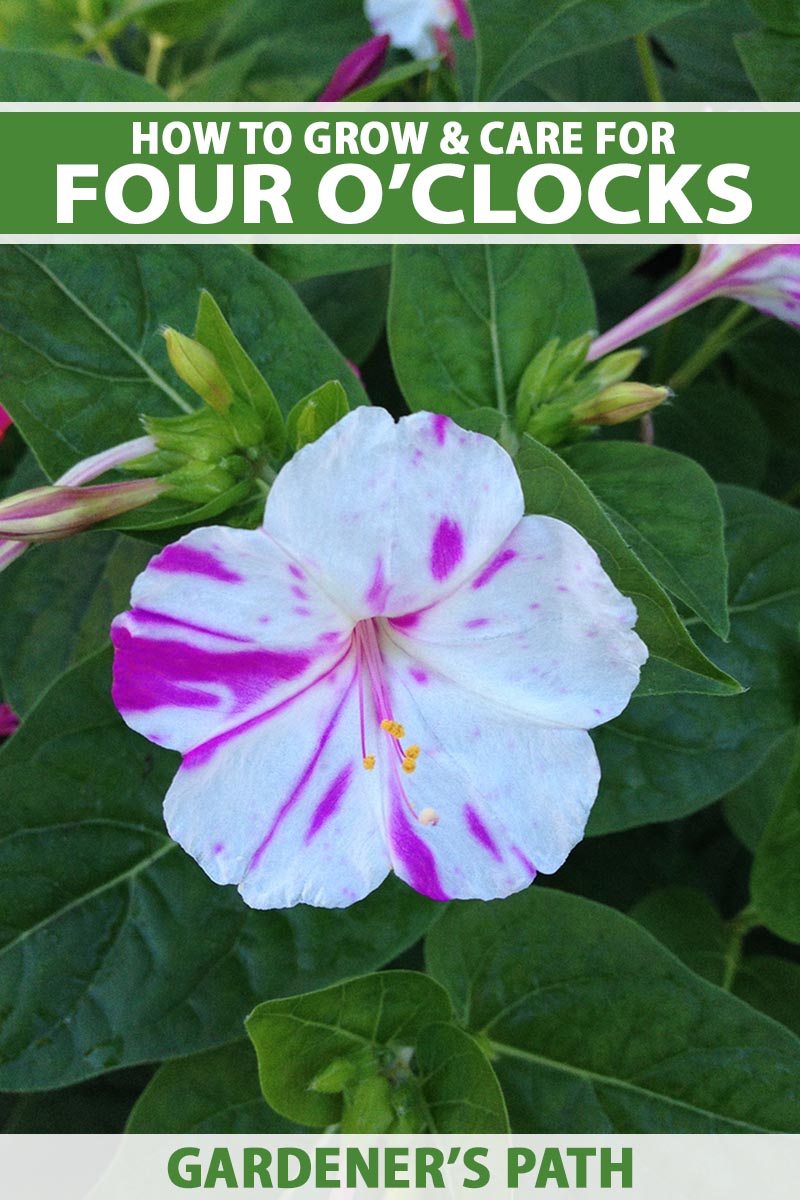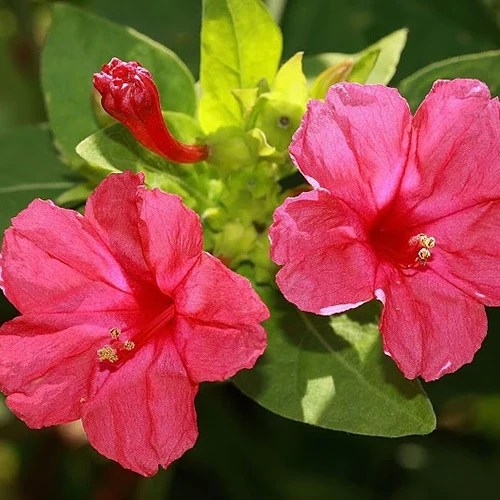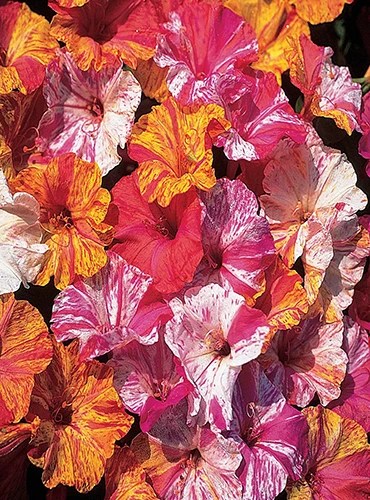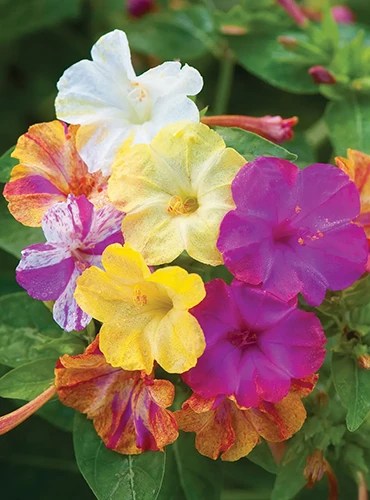Mirabilis jalapa
Did you know there ’s a plant advert after a time of day ?
And while you may recall the rather old - fashioned four o’clock ( Mirabilis jalapa ) from visit to Grandma ’s sign , the name of the plant is n’t a reflection of when our older relatives often run to exhaust dinner party .
Instead , the name indicates the fourth dimension of day when the plant ’s cornet - shaped flowers open .

We link to vendor to help you find relevant products . If you corrupt from one of our link , we may earn a perpetration .
The heyday blossom in belated afternoon in reply to a temperature drop . Nocturnal moths and other nighttime pollinator are draw in to their ambrosia .
They persist undetermined throughout the nighttime and into the break of day when temperatures climb up and the peak droop . Likedaylilies , four o’clock flowers flower just a single time , then slice and finally fall off the plant .

On cloudy days , the peak give earlier and sometimes wo n’t close at all . Again , this is not due to a deficiency of light , but rather , to temperatures that are lower than usual .
Many gardener find deadheading unneeded because even the wilted blush are attractive , and this plant blooms profusely with or without deadheading .
Whether you ’re drawn by nostalgia or you ’re looking for an appealing , colorful , easy - tending perennial for a cottage garden , borderline , or container , you ’ll want to contain out this honest-to-goodness - fashioned pet .

Here ’s what to ask in this guide :
What You’ll Learn
What Are Four O’Clock Flowers?
stamp perennials in Zones 7b to 11b , gardeners in other Zones often grow these knockout as annuals . They will self - sow .
This bushy nocturne usually grows one to four feet tall , and one to three ft wide , but repeated plant have been known to get hold of six feet in height in ideal conditions .
It is heat- and drought - large-minded , and a favorite of hummingbird , bees , butterflies , and other pollinator .

Wild critter have sex not to take in the roots and seeds of this plant , because they are vicious .
If your barker has a propensity for eat random pace objects , you may require to collect the dark , leathery , rotund seeds instantly after they make a screening , or decamp grow this older - fashioned ornamental altogether .
In the deep Dixie , M. jalapabegins blooming in belated spring , while northern gardeners will have to wait until midsummer to catch a puff of air of the extremely fragrant blooms .

Cultivation and History
As if “ four o’clock ” were n’t an interesting enough name , this plant also goes by “ marvel of Peru , ” a nod to its native tropic South American home ground .
This blossom has been cultivated for hundred of year .
Indigenous hoi polloi used the roots for medicine and as a hallucinogen , and Europeans find the plants in the Americas and brought them back to their land around 1540 .

In those day , the red-faced flower were used to make food coloring .
In its bloom a couple of generations ago , this was a popular “ pass - along ” plant in the southern US , meaning neighbors and friends frequently shared the flora with each other to grow in their own garden .
Propagation
Four o’clocks grow well from semen , and it ’s not that tough to grow them from Tuber uprooted at season ’s end , winter over , and planted out again the following spring .
Here ’s the go - to information for either access :
From Seed
One huge vantage of four o’clocks is that even beginners can succeed at growing them from seed .
And you may collect the heirloom seed at season ’s end to share or bulge more plants .
In areas with a shorter spring up time of year , you may require to start four o’clocks indoors six to eight week ahead of your area ’s ordinary last frost date .

Fill tray or small mass with seed - starting premix . If you bid you may prefer to soak the seeds overnight in warm piddle to speed up sprouting .
The semen need light to germinate , so space them a few inches apart and merely press them into the soil about a quarter - inch .
Place the container in a room with temperatures between 65 and 75 ° F , and where it will receive light either from a window or agrow light .

Keep the soil moist with a clean spray bottle of water supply . you may expect the seeds to germinate within about 15 days .
Once they ’re a couple of inches marvelous and have at least two sets of true leaves , transplant the seedlings to two - inch cells or into the container where you plan to grow them for the season .
seedling can go in the garden when they ’re about six weeks old , after you ’ve gradually conditioned them to the increase light and warmth of the not bad open air .

indurate them off when conditions permit for about an hour on the first day , adding an hour each day for about a workweek .
softly take them from their batch or seminal fluid - starting cellular telephone , and implant them to the same depth as in their container . Provide plenty of water as they get acclimated .
To direct sow in the garden , quad the seeds about 12 inch apart , encompass them with a quarter - inch of fine territory and keep them moist until they burgeon forth .

From Tubers
To share tubers with a friend or save them at time of year ’s end to plant out next year , dig up them up with a gardening crotch or spade , being thrifty to unearth the total tuber to avoid unintentionally hurt it or slice off a destiny .
Then use your shovel or your hands to gently remove the cluster from the garden , much as you would whenlifting Dahlia pinnata .
stimulate the soil from the tubers and hive away them somewhere nerveless and dry – but not freezing – like an unheated garage .

Good melody circulation is significant – some gardeners will layer them between rag of newspaper in an open crateful or box with holes punched in it .
The following year , plant them after the last frost .
Space them one or two foundation apart and engraft them deeply enough to cover with the root end pointed down and the crown end where new growth will emerge found just below the grunge surface .

How to Grow
You may have find out dramatic narration about four o’clocks mature in extra - poor dirt or pull through a months - long drouth . And indeed , they are tough and large-minded .
But instead of relying on this survival inherent aptitude , to grow the healthiest four o’clocks with the most blush , implant them in well - drain filth that ’s been amended with elderly compost or other organic stuff .
acquire them in full sun or an field that receives break of the day sunlight and good afternoon specter .

If you ’re growing them in container , plant four in a pot 20 column inch in diameter that can hold at least five congius of acquire medium .
Be trusted to water the plants during dry piece if you want them to look fabulous , versus just mother by .
Aim for about an column inch of supplemental water every couple of workweek if your area is experiencing periods of high heat or zero rain .

As for fertilizer , these plants can do without it .
But they ’ll wave and blossom with abandon if you give them an all - function balanced fertiliser in early spring and at least once midway through the growing time of year , or once a calendar month if your territory is lacking in prolificacy .
Growing Tips
Pruning and Maintenance
Those grow four o’clocks from seed can pinch back the master stem when green seedlings are about five or six inches tall . This will boost sturdy flora that bloom profusely .
Also check that to pick off any seeded player that you do n’t want to self - sow , or pull up the fresh seedling before they get a fastness in the garden or other domain where you do n’t require them to mature .
For anyone lucky enough to have the chance to grow four o’clocks as perennials , there are a dyad of extra seasonal chores you ’ll need to take on .

Ahead of nerveless temperatures each year , ensure to jog any dead or discredited foliage .
Add atwo - inch layer of mulcharound the stems to help the plant retain moisture through their dormant period .
Be certain to opt for a pollinator - favorable mulch , one that has n’t been treated with pesticides , like wry shredded leaves from your own garden or untreated pine stubble .

Cultivars to Select
If color is your thing , you ’ve come to the right spot .
Four o’clock flowers can be pinkish , crimson , Battle of Magenta , lilac , yellow , or white .
The blossom may be a substantial hue , or they may have more than one color in a striped , splotchy , or spotted pattern .

You may even see different combinations of shades and patterns on a single plant .
And to further brighten your years , the flowers of some varieties will exchange color as the flora matures .
So , you corrupt a lovely yellowed plant at the garden store in May , and take the air out one July evening – around the prison term when Grandma ’s cooking dinner party – to identify you now have a plant with saturnine pinkish flower !

You may want to buy ejaculate in a particular nuance or see if you ca n’t scare up some starts from neighbor or a local gardening clubhouse .
There are also seeds available from reputable vendors online . Few will have a specific cultivar name , usually being tagged just as “ four o’clocks , ” perhaps with a color named afterward .
Red Four O’Clocks

For example , you’re able to find reddened - flowering seedsavailable from Eden Brothersand yellow - flower one availableat Outsidepride via Amazon .
Marvel of Peru
If you ’d care to mix it up , a accumulation of bicolor , red , Battle of Magenta , white , and yellow wonder of Peru germ are sold in 25 - seed packetsfrom Botanical Interests .

As for more specific cultivar , consider these :
Kaleidoscope Mix
A Burpee - bred mixture , these four o’clocks are all bicolored or multicolored and dramatic , some of them with deep orange and apricot blooms , others a creamy livid with Battle of Magenta highlights , and still others in light pinko and bright white with clean orange tree portions .
These are a instinctive option for tropic plantings or splashy container ornamental for the porch or summerhouse .
Kaleidoscope Mix is useable in 45 - seed packetsfrom Burpee .
Marbles Mix
This option sports striped , one - and - a - half - inch flush that are pink , rosaceous , red , and yellow , all in a marbled pattern . The perfume is finespun and redolent of orange blossom .
Marbles Mix is useable in 35 - seed packetsfrom Burpee .
Managing Pests and Disease
One of the reasons these colorful industrial plant are so sympathetic is that they are resistive to deer marauders , and are n’t devil much by other pestilence or diseases .
There are a few potential foes to watch for though , including these :
Pests
As mentioned above , critters seem to know not to eat these works , though you may want to determine out for your dogs if they ’re prepared to crunch whatever is in their path .
About the only insect that might attack is the aphid , an unappealing petty sap - sucker that ’s oval in shape and may come along in any number of people of color , including buff , brown , or green .
you could nail aphid with a steady flow of piss , or keep up some of the otherstrategies outlined in our guide .
Should you spot leaves that look like they ’ve been chewed on and you may peer flop through the damage , you may be battling slugs .
Another indicator is the pleasant slime trail they get out behind … Just kidding , they ’re gross !
A top scheme for proceed slugs at bay involvesdiatomaceous earth – show more about it in ourguide to keeping slug and snail under control .
Diseases
Again , these are tough plants . But they ’re not imperviable to these potential plant disease :
A soil - borne fungus can make Fusarium wilt disease , putting four o’clocks in a unsound agency .
You might acknowledge they ’re flag , a symptom that ’s normally followed by yellow leaves .
Unfortunately , ornamentals that are suffering from fusarium wilt ca n’t stage a counter . Instead , you ’ll need to pull up all the moved plants , taproots and all , and send them to the scum bin , not the compost .
Then ensure to move any healthy plant to a new spot for next year , following the instructions for overwintering tubers outline in the Propagation section above .
If you see small , yellow-bellied , halo - shaped spots on the leaves , your plants may have leafage blight . Ack !
These place start small but they can move around brownish and cause the leave to wither pretty promptly .
About the only manner to handle this ill is to eradicate all of the affected industrial plant .
If you notice reddish - brownish topographic point on the foliage or stem , your plant life might have rust .
If you determine that ’s the stipulation , work rapidly to remove the unnatural leaves and stem , then regale the remainder of the plant with neem oil .
Bonide Neem vegetable oil
Try this product from Bonide , available from Arbico Organics .
Saving Seeds
Since these are such sorcerous plant to share with tiro gardeners and those who are nostalgic for simpler times , it ’s handy that the seeds are so simple to save .
After some of the flowers have faded , you will require to start pick up the seeds they produce before they get dispersed onto any available soil , where they ’ll sprout next bound .
front for the low , dark , football - forge seeds to appear at the top of the root after the dead flush drop . These are really fruits , which entertain the seed inside .
nibble them directly from the flora , and do n’t forget to bet for extras that have already fallen to the dry land .
Place them on a musical composition of chocolate-brown paper or composition board , and gear up it out of the visible light in a nerveless spot where tune diffuse freely .
allow the seeds dry out totally before you stack away them . That commonly takes about a calendar week , and you ’ll know they ’re dry when the surfaces are so backbreaking you ca n’t deflate them with your thumbnail .
For long - full term store , move the dry out seeds to small envelope or little glass jars with screw - on lids . Be certain to label the containers with the plant ’s name and the date when you reap seed .
Move those container somewhere dry and dark for the continuance , until you ’re quick to take them out again for gifting or sowing .
Best Uses
Along with being a lovely admonisher of simpler times in the past , four o’clocks can bind their own with the most colorful decorative bedding plants of today .
Planted close together , they form an attractive yearly hedging that butterflies and hummingbird will home in on .
They also grow well in containers on the terrace or a garden wall , as long as you ’re willing to offer up a moment of special supplemental lachrymation throughout the driest lot of the summertime .
Their quondam - fashioned appeal plays well in acottage garden , but the people of colour and drought - permissiveness also make them suited for tropic plantings . For the latter , grow them in front of tall tropicals like elephant ’s auricle .
Perhaps the best utilisation ofM. jalapais as a pretty flower to share with beginner gardener .
It ’s a snap to save seed or lift genus Tuber , and neighbors , grandkids , and the local semen library could all enjoy the nostalgic beauty of this jolly repeated .
Quick Reference Growing Guide
A Time-Honored Flower Tradition
There ’s never a bad time to imbed these colorful beauties .
ordination seeds or ask a neighbor for a “ pass - along , ” and help to revive a plant from an earlier time that certainly deserves a comeback .
And if you ’re planning to incorporate more old - fashioned ornamentals into your garden or landscape painting , read these flower guidesnext :
© Ask the Experts , LLC . ALL RIGHTS RESERVED.See our TOSfor more details . earlier published January 26 , 2019 by Gretchen Heber . Last updated May 4 , 2023 . production photo via Arbico Organics , Botanical Interests , Burpee , and Eden Brothers . Uncredited photos : Shutterstock .
About
Rose Kennedy